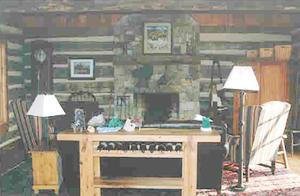 |
|
Log Homes Provide Classic Looks . . . And Stylish Living!by KRISTEN ARMSTRONG, Staff Writer |
|
| First built in the United
States around 1640, log cabins can evoke a strong sense of history and
bring people back to the days of old. Unlike other relics of the past,
however, log cabins have a place in today's world. Homeowners can take part in American history by restoring, rebuilding or preserving their own log cabin. And a number of Loudoun residents are doing just that. William Scott, who lives between Marshall and Middleburg, essentially built his log house from scratch. (It is a log house because it has two stories, whereas a log cabin traditionally only has one.) Although he purchased and used pieces from a disassembled West Virginia cabin, Scott collected and reclaimed much of the cabin's wood, himself, from area farms and houses. “Many people take down a cabin that exists and rebuild it with new furnishings inside,” Scott said. “I think it is a much better idea to express your own concepts by acquiring the wood, flooring and so forth, and building your own.” The wood used in Scott's log cabin includes pine, oak, walnut and chestnut. The cabin was assembled the old-fashioned way. “We used big flat-ax hatchets, and shaped each log to fit the next one,” he said. The house also has a stone fireplace that includes one of Scott's favorite features of the house. While Scott was collecting materials for the log house at a torn-down barn in West Virginia, he found fossils in the barn's stone foundation. Two pieces of that rock are now part of the stone facade of the fireplace. Scott finished the 20-by-40-foot cabin in about three-and-a-half years, with the help of builder Luther Breeden and his crew. The total cost of the project was approximately $400,000. In the spirit of preserving history, Scott plays down the modern amenities the house offers, and uses antiques and reproductions as much as possible. The kitchen, for example, has a 1920s toaster and reproduction stove. A lot of the house's furniture dates back to the 18th century. “The overall results are stunning,” Scott said. Norman and Carolyn Smith of Middleburg also believe strongly in keeping a part of American history alive through their log cabin. Their half-one-story, half-two-stories log home, called a salt box, was built by Lord Fairfax and is historically confirmed as his oldest residence, Carolyn Smith said. The cabin, originally situated on the Smith's property near the Wolf Trap area of Tysons Corner, was supposed to be bulldozed after they sold the land. But the couple commissioned the help of the state archivist and state historian to see if the home was worth moving and rebuilding. “In the process, we discovered through several means that they were able to date the house to the early 1700s,” Smith said. “It was a very historically valuable piece of property.” The Smiths had the home taken apart, log by log, and had it moved to Middleburg on a flatbed truck. “It's preserving early Americana,” Smith said. “We preserved a piece of history.” Physically preserving the history is not always easy. Log homes require specialized care that others do not. When building, rebuilding or restoring a log cabin, homeowners must pay special attention to the structure's water resistance. “Make sure you have a ‘Type A' personality with the cabin's structure,” said Christopher Knoedler, owner of the Allegro Solutions restoration company. “Home owners have to make sure that everything continues to be watertight. As soon as water gets into the chinking (narrow cracks), it freezes, expands and breaks it. That's probably the biggest downfall log cabins have.” Even though homeowners might have to put more effort into taking care of their home, the log homes have a lot of appeal, and they are a precious commodity. “There aren't too many of them, and they can be hard to find,” said Thomas and Talbot Realtor Mary Ann McGowan. “They give a historic, warm and comfortable feeling. People love that kind of charm.” |
 Interior shots showcase the stylish looks of a log cabin built by William Scott, who lives in Hunt Country. |